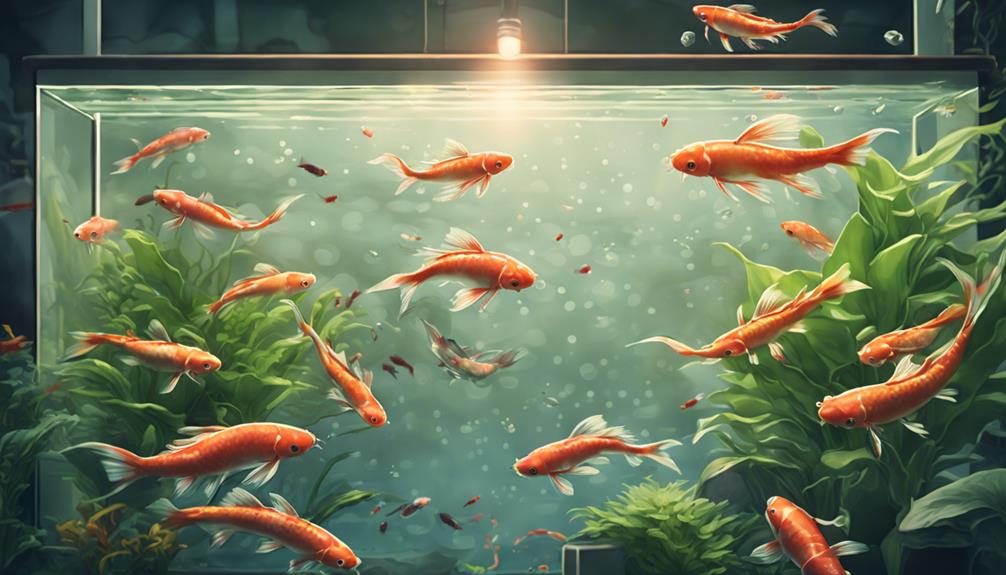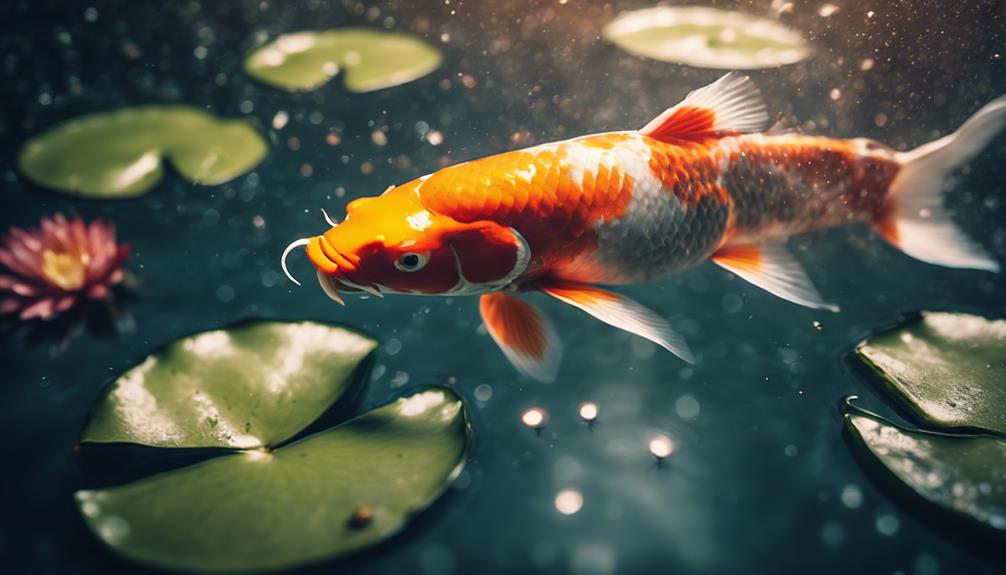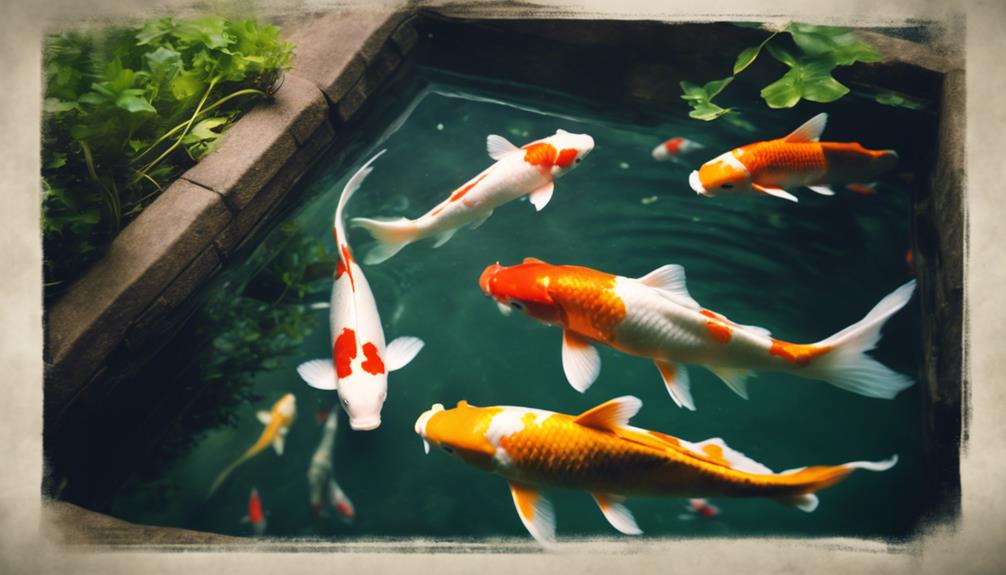You understand that maintaining superior water quality is vital to breeding healthy, vibrant koi fish, as even slight imbalances can stress your fish and jeopardize their reproductive success. Clean water matters because it guarantees a stable and healthy environment, allowing your koi to thrive. Poor water quality can lead to disease, stress, and even death. A reliable filtration system, regular water testing, and adjustments to pH, ammonia, and nitrite levels are all essential to creating a balanced ecosystem. By controlling water quality, you can optimize breeding conditions and increase the chances of producing high-quality koi – and that's just the beginning of your koi breeding journey.
Table of Contents
Key Takeaways
- Clean water prevents stress in koi fish, making them more susceptible to disease and reducing breeding success.
- Regular water testing and adjustments maintain a stable and healthy environment for koi, crucial for breeding and growth.
- A reliable filtration system and regular cleaning of filter media remove built-up toxins and preserve superior water quality.
- Sudden changes in water conditions can stress koi, making them more susceptible to disease and impacting breeding success.
- Maintaining optimal water parameters, including pH, ammonia, and nitrite levels, ensures a healthy environment for koi fish breeding.
Debunking Koi Breeding Misconceptions
One of the most pervasive misconceptions about breeding koi fish is that it's a straightforward, effortless process, but nothing could be further from the truth.
You might think that simply putting a male and female together would guarantee success, but the reality is far more complex. Breeding quality koi requires a deep understanding of water chemistry and a significant investment in infrastructure, including large mud ponds designed to maintain superior water quality.
In reality, a single large koi can produce up to half a million eggs, but this doesn't guarantee success.
The breeding process is a delicate balance of timing, coordination, and precise control over water quality. You'll need to carefully prepare and fertilize your mud ponds to promote live food growth, and then induce ovulation in your females using hormone injections.
With so many variables at play, it's no wonder that quality koi command high prices. By recognizing the complexity and labor involved in koi breeding, you'll be better equipped to tackle the challenges and reap the rewards of this intricate process.
Pond Preparation and Fertilization
When you're setting up a koi breeding pond, you'll want to ponder a mud pond design that allows for efficient water circulation and aeration.
This design will help you maintain prime water quality control, which is vital for the health and well-being of your fish.
Mud Pond Design
As you design a mud pond for koi fish breeding, you'll need to prepare the pond floor by excavating it to a suitable depth and creating a gentle slope to facilitate easy drainage and aeration.
This slope will prevent water from stagnating, which can lead to poor water quality and negatively impact your koi's health.
Next, you'll want to install a pond filter to maintain clean water. A biological filter is ideal, as it utilizes beneficial bacteria to break down waste products and convert them into harmless compounds.
Consider the water temperature when selecting your filter, as it will affect the filter's efficiency. For peak results, confirm your filter can handle the pond's water volume and temperature range.
A well-designed mud pond with a suitable filter will provide a healthy environment for your koi to thrive. By following these guidelines, you'll be well on your way to creating a thriving koi breeding operation.
Water Quality Control
You'll need to test and adjust the water's pH, ammonia, and nitrite levels to guarantee a stable and healthy environment for your koi, as these parameters have a direct impact on their well-being.
Regular water testing will help you identify any imbalances and make necessary adjustments to keep the water safe for your fish.
Maintaining a stable pond water condition is crucial, as sudden changes can stress your koi, making them more susceptible to disease.
To control ammonia levels, you'll need to incorporate a reliable filtration system, complete with adequate filter media.
This will help break down waste products and keep the water clean.
Regularly clean your filter media to verify its efficiency.
Additionally, perform partial water changes (about 10-20% every week) to remove built-up toxins and preserve superior water quality.
By staying on top of water quality control, you'll create a thriving environment for your koi to grow and flourish.
Live Food Cultivation and Fry Growth

Cultivate live foods, such as brine shrimp or rotifers, to provide your koi fry with essential nutrients during their critical growth stages.
As a breeder, you want to guarantee your koi fry receive the best possible start in life.
Live foods are an ideal food source for koi fry, offering a rich supply of nutrients that promote healthy growth and development.
To cultivate live foods, you'll need to create ideal conditions that mimic their natural habitats.
For instance, brine shrimp thrive in saltwater environments with specific pH and temperature levels.
Rotifers, on the other hand, require freshwater environments with ample aeration.
By providing live foods in perfect conditions, you'll give your koi fry the best chance of survival and growth.
Remember, a healthy food source is critical to producing strong, vibrant koi.
Timing and Coordination of Breeding
When you're breeding koi fish, timing is everything.
You'll need to carefully coordinate the breeding cycle to guarantee peak results, considering factors like weather conditions and the readiness of your female fish.
Breeding Cycle Timing
By synchronizing breeding with the koi fish's natural reproductive cycle, breeders can optimize spawning and improve the overall success of their breeding program. This means understanding when the breeding season begins and ends, and preparing your fish accordingly.
During this time, you'll want to guarantee that both male and female koi are healthy and ready to spawn.
The breeding season typically occurs in the spring and early summer, when water temperatures are between 15°C to 25°C (59°F to 77°F).
Male koi will develop white, breeding tubercles on their pectoral fins and scales during this time, indicating they're ready to spawn.
Female koi will become plump and swollen with eggs, which can number up to a million or more.
You'll want to provide a suitable environment for spawning, including a separate breeding tank with adequate filtration, water quality monitoring, and a substrate for the eggs to adhere to.
Weather Condition Factors
As you prepare your koi for breeding, you'll need to monitor and adapt to weather conditions that can substantially impact the timing and coordination of your breeding program.
Weather conditions can affect the body of water, influencing the koi's behavior and physiology. For instance, sudden changes in temperature or precipitation can stress your fish, making them more susceptible to disease and less receptive to breeding.
You should also consider the surface area of your breeding pond, as it can be affected by weather conditions.
Strong winds or intense sunlight can increase evaporation, altering the water's chemistry and affecting the koi's comfort level. To guarantee the right conditions for breeding, you should aim to maintain a stable water environment.
This might involve providing shade, aerating the water, or using a pond cover to regulate temperature and reduce evaporation.
Female Readiness Signs
You'll need to accurately determine your female koi's readiness to spawn, a critical step in the breeding process that requires careful observation and examination of specific physical and biological indicators. This timing is pivotal, as it directly affects the success of the breeding process.
To determine readiness, you'll need to examine your female koi's eggs, which can be obtained through a catheter inserted in the vent. Under a microscope, you'll be able to see the position of the nucleus in the egg, with a more off-center nucleus indicating greater readiness.
Some key signs to look out for include:
- A swollen and pinkish vent area, indicating the female's readiness to spawn
- A swollen and soft abdomen, further indicating her readiness
- The presence of eggs with an off-center nucleus, as observed under a microscope
- The female's response to hormone injections, which can induce ovulation but still require natural readiness for successful breeding
Factors Affecting Ovulation and Health

Several physiological and environmental factors substantially impact ovulation and overall health in koi fish, making it crucial to understand and control these variables in a breeding program.
As a koi breeder, you need to be aware of the factors that influence ovulation, as it's a critical aspect of successful breeding.
For instance, water temperature plays a significant role in inducing ovulation in koi fish. You should maintain a consistent water temperature between 15°C to 20°C to stimulate ovulation.
Additionally, you should guarantee that your koi fish are well-fed and healthy, as malnutrition can negatively impact ovulation and overall health.
Water quality also has a direct impact on koi fish health, and you should maintain ideal water parameters to prevent stress and disease.
You should also consider the social hierarchy within your koi population, as dominant fish can suppress ovulation in subordinate fish.
Importance of Water Quality Testing
Proper water quality testing is essential to identify potential issues that could jeopardize the health and reproductive success of your koi fish.
As a breeder, you understand the importance of providing a healthy environment for your fish to thrive. Clean water is vital, and regular testing helps you detect any imbalances or contaminants that could harm your fish.
Regular water quality testing allows you to:
Monitor ammonia and nitrite levels, which can be toxic to your fish
Check pH levels, ensuring they're within the suitable range for your koi
Measure oxygen levels, as fish require oxygen to breathe and thrive
Analyze nitrate levels, which can affect the quality of your fish food and overall water quality
Frequently Asked Questions
Can Koi Fish Live in Dirty Water?
You might think koi fish can thrive in dirty water, but the truth is, they can't survive for long in filthy environments with toxic buildup, which leads to stress, disease, and death if you don't maintain good water quality.
Do Koi Fish Need Clean Water?
You understand that koi fish can survive in dirty water, but you realize they need clean water to thrive, as ideal water quality directly impacts fish health, making regular tank maintenance and efficient water filtration vital.
Why Won't My Koi Breed?
You're wondering why your koi won't breed? Check if your fish have reached breeding age, as stress from poor water quality or fluctuating water temperature can hinder reproduction, and consider the possibility of a genetic issue.
How to Encourage Koi to Spawn?
'You're basically a koi matchmaker! To encourage spawning, you'll need to create the perfect environment. Trigger spawning with gradual water temperature increases, guarantee superior egg quality, and observe mating rituals to optimize breeding success.'
Conclusion
As you wrap up your koi breeding journey, remember that clean water is the unsung hero.
It's the thread that weaves together every stage, from pond prep to fry growth, and ultimately determines the success of your breeding program.
Without it, even the best-laid plans can go awry.
So, prioritize water quality testing and maintenance, and reap the rewards of healthy, thriving koi.
After all, a crystal-clear pond is the best nursery for your precious fish.

